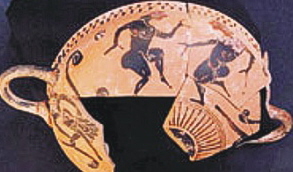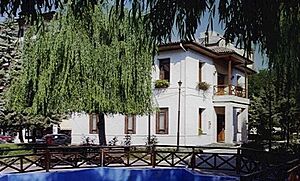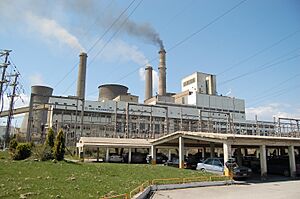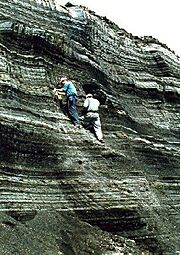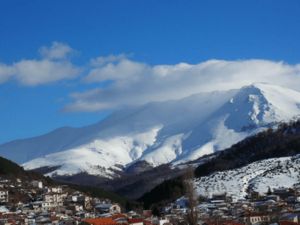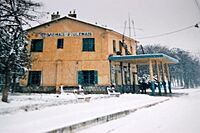Ptolemaida facts for kids
Quick facts for kids
Ptolemaida
Πτολεμαΐδα
|
||
|---|---|---|
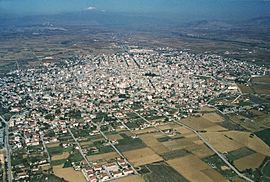
Aerial view of Ptolemaida
|
||
|
||
| Country | Greece | |
| Geographic region | ||
| Administrative region | Western Macedonia | |
| Regional unit | Kozani | |
| Municipality | Eordaia | |
| • Municipal unit | 217.901 km2 (84.132 sq mi) | |
| Elevation | 600 m (2,000 ft) | |
| Population
(2021)
|
||
| • Municipal unit | 35,334 | |
| • Municipal unit density | 162.1562/km2 (419.983/sq mi) | |
| Community | ||
| • Population | 31,575 (2021) | |
| • Area (km2) | 57.508 | |
| Time zone | UTC+2 (EET) | |
| • Summer (DST) | UTC+3 (EEST) | |
| Postal code |
502 00
|
|
| Area code(s) | 24630 | |
| Vehicle registration | KZ | |
| Website | www.ptolemaida.gr | |
Ptolemaida (Greek: Πτολεμαΐδα, romanized: Ptolemaïda) is a town in the Kozani region of Western Macedonia, Greece. It used to be a separate town but is now part of the larger Eordaia municipality. Ptolemaida is well-known for its large coal (called lignite) mines and the power stations that use this coal to make electricity.
Contents
Why is Ptolemaida called Ptolemaida?
For a long time, during the Ottoman Empire, the city was known as Kayılar. This name came from the Kayı tribe, which was the tribe of Osman I, who founded the Ottoman Empire.
In 1927, the city's name was officially changed to Ptolemaida. This new name honors Ptolemy I Soter. He was a close friend and general of Alexander the Great. Ptolemy I Soter later became the founder of the Ptolemaic dynasty in Egypt. It is believed that he and his daughter, Ptolemaïs, came from this area. You can even see a statue of Ptolemy I Soter in the main square of the city today.
A Look at Ptolemaida's Past
Archaeologists believe that people have lived in the Ptolemaida area for a very long time, possibly since 6000 BC.
Ancient Farming Villages
In 2005, archaeologists found the remains of two old farming villages. These villages date back to the Neolithic period, which was a time when people started farming. These villages were important trading spots and the people living there even knew how to work with metals.
In 2006, a golden necklace was found that is about 6,500 years old! It was a flat, ring-shaped item that likely had a special meaning. It was probably worn by an important person in the community.
Recently, 16 more ancient houses were found in Lake Zazari near Ptolemaida. These houses were in the lake itself and became visible when the water level dropped. This discovery helps us learn more about how people lived in the Neolithic era.
Early Greek Times
Over the last 30 years, many ancient items have been found in the Ptolemaida area, especially because of mining work. For example, pieces of pottery from the 6th century BC have been discovered.
Archaeologists also found two ancient Macedonian graves. These graves are from the 5th century BC.
The Macedonian Kingdom
Around 336 BCE, the area around Ptolemaida became part of the growing Kingdom of Macedon. This happened under the rule of Philip II of Macedon. Later, his son, Alexander the Great, fully brought this region into Macedon. It is said that two of Alexander the Great's six main generals, Ptolemy I Soter and Aristones, came from this very region.
The Hellenistic and Roman Eras
After Alexander the Great died, his large empire was divided. Macedon became an important kingdom during this time. There were many battles between the Macedonians and the Romans. The Romans wanted to control this area because an important road passed through it.
Macedon remained strong until the Battle of Pydna in 168 BC. In this battle, the Roman general Aemilius Paulus defeated King Perseus of Macedon. This battle ended the rule of the Antigonid dynasty over Macedonia.
During the Roman period, Ptolemaida and all of Macedonia became part of the Eastern Roman Empire in 395 AD.
Byzantine and Ottoman Rule
Over many centuries, Ptolemaida was part of different empires and kingdoms. These included the First Bulgarian Empire, the Latin Empire, and the Despotate of Epirus.
During the time of the Ottoman Empire, Ptolemaida was known as Kayılar. Many nomadic shepherds, called Yörüks, moved to Macedonia from Asia Minor before 1360. Later, many noble families also moved here. By the early 20th century, the number of Turkish people in the area started to decrease.
Modern Ptolemaida
Greek forces took control of Ptolemaida on October 15, 1912, during the First Balkan War. The city then became part of Greece. In 1924, many Turkish residents left, and Greeks from Anatolia moved to Ptolemaida. This was part of a large population exchange between Greece and Turkey. After this, Ptolemaida became a city with mostly Greek residents again.
In the 1970s, some of Greece's largest power plants that burn coal were built near Ptolemaida. These plants produce a lot of electricity but also cause pollution. They are expected to close down by 2028.
Culture and Fun in Ptolemaida
Ptolemaida has its own football club called "Eordaikos". There are also other teams like AE Ptolemaidas. The city has many schools, including high schools and middle schools. You can find churches, banks, a post office, and a train station. There is also a police station and many public squares. The city is home to the Anthropological and Folklore Museum, where you can learn about the history and traditions of the area.
Ptolemaida's Economy
Ptolemaida is a very important industrial area for Greece. It has the largest deposits of lignite (a type of coal) in the country. These deposits provide about 80% of Greece's national coal production.
The four power plants in this area use the local lignite to produce electricity. Together, they create about 70% of Greece's total electrical power! The Public Power Corporation (DEI) owns these plants and is a major employer in the city.
Learning in Ptolemaida
The city is home to parts of the University of Western Macedonia. It has two departments from the School of Health Sciences: Occupational Therapy and Midwifery.
Ptolemaida's Climate
Ptolemaida is located in the middle of the Eordaia plain. It has a climate that can be hot in the summers, sometimes with thunderstorms. Winters are among the coldest in Greece. In fact, the lowest temperature ever recorded in Greece was in Ptolemaida: -27.8°C (-18°F) on January 27, 1963.
Who Lives in Ptolemaida?
The first people to settle in Ptolemaida were Turks after the Ottoman Empire took over Macedonia. They were the majority until the population exchange in 1924. Between 1924 and 1926, many Greeks who had to leave Anatolia settled here, making Greeks the majority.
Today, the city of Ptolemaida has about 31,575 residents (as of 2021). The entire municipality of Eordaia, which includes Ptolemaida and 11 smaller communities, had a total population of 35,334 residents in 2021.
| Year | Community | Municipal unit |
|---|---|---|
| 1940 | 7,719 | - |
| 1951 | 8,816 | - |
| 1961 | 12,747 | - |
| 1971 | 16,588 | - |
| 1981 | 22,109 | - |
| 1991 | 25,125 | 32,775 |
| 2001 | 30,017 | 36,393 |
| 2011 | 32,142 | 37,289 |
| 2021 | 31,575 | 35,334 |
Ptolemaida's Location
The city is located in the Eordaia valley. It sits between the Askio mountains to the southwest and the Vermio mountains to the northeast. Ptolemaida is north of Kozani, east of Kastoria, and south of Florina. The A27 motorway (which is part of E65) passes just east of the city.
Friendship Towns
Ptolemaida has a special friendship with another town:
 Enkomi, Cyprus
Enkomi, Cyprus
Famous People from Ptolemaida
- Pantelis Kapetanos, a football player
- Ieroklis Michailidis, an actor
- Stiliani Papadopoulou, a hammer thrower
- Iordanis Konstantinidis, a Greco-Roman wrestler
- Mazlum Kayalar, a Turkish politician
- Yıldız Eruçman, the first Turkish female parachutist
See also
 In Spanish: Ptolemaida (Grecia) para niños
In Spanish: Ptolemaida (Grecia) para niños




